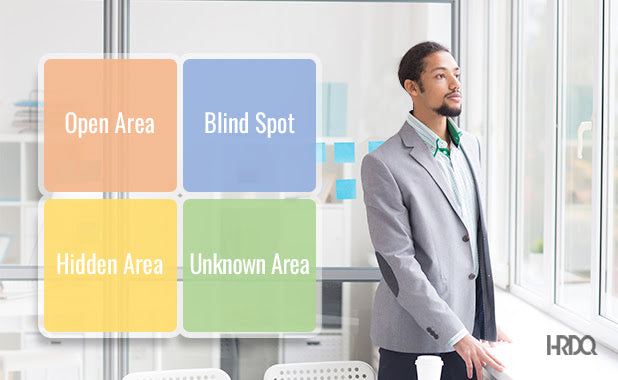
Share
What Is the Johari Window Model and How Does It Work?
HRDQ StaffThere's a powerful tool from psychology that helps us learn about ourselves and how others see us; they call it the Johari Window Model. Picture a window with four sections, each showing a different part of who we are. More than a big idea, it's a tool we can use to grow as individuals and work better as a team.
People often use it for exercises that help them see themselves better and during moments that build up a team. It helps us and our teammates peek into what makes us tick. And it's got a lot to show – from stuff we choose to show to the world to the characteristics we hide, all the way to things we're unaware of!
I have to hand it to its creators, Luft and Ingham - they sure had a vision that was ahead of its time. Their model is a genius way of helping us understand ourselves and others better.
Let's peel back some layers and look closer at this model. You'll be surprised by the valuable lessons it can teach us!

- Enhances creative problem-solving skills.
- Avoids common critical thinking errors.
- Systematically evaluates information and ideas.
Table of Contents
What Is the Johari Window Model?
Joseph Luft and Harry Ingham introduced the world to a unique tool called the Johari Window Model in 1955. This model helps people get to know themselves better. At the same time, it's all about communication and relationships between people.
Our chat begins with a four-part model: the open area, the blind spot, the hidden area, and the unknown area.

The real magic of this Johari Window Model happens when we start to crack ourselves open a bit more – it's about expanding that open area. And why not? Bigger open areas mean heartier chats and honest connections. But to make a difference, I have to start showing more of our cards and be open to people's feedback – that's how we trim down our hidden area.
The fascinating bit of the model is the "unknown area." Just think about it: a place loaded with uncaptured talents, unrealized skills, and surprise fears. What if we dared to dig into this spot, either alone or with a helping hand? We might just stumble upon strengths we never even dreamt we had.
This serves a real purpose; it encourages us to see ourselves in a new light, helps us assess feedback from others, and pushes us to become the very best we can be.
Let's crack open each of these four quadrants.
Quadrant #1 - Open Area
The "Open Area" is like the front living room in your house. Everybody can see what's there, including you. It is the first part of the Johari Window model, a tool that helps us understand our personality. The things this part shows about us aren't only known to us but to everyone else, too.
Imagine this for a second. You're sitting in a job interview, and the boss asks you what you're good at. You might say, "I get things done, have great organization skills, and work well in a team." This answer is a perfect example of the Open Area because it's about things both you and the boss are aware of.

But here's an interesting thing: the Open Area can change in size. It can get smaller or larger, depending on how much we learn about ourselves and how well we take in feedback. For instance, learning something new about yourself can make your Open Area bigger. And so can accepting a behavior that someone else pointed out to you.
Moreover, a larger Open Area can significantly benefit your personal and work relationships. It helps build trust and can lead to better teamwork. Remember, though, that this process depends on how open you're willing to be and how receptive others are to you.
Quadrant #2 - Blind Spot
Picture this: you're part of a lively chat with your peers. You're feeling assertive, and your voice is strong. But what if you're coming across way too intense without knowing it? What if you're tapping a pen without realizing it? That is what we call a "blind spot." Interesting, right?
These unnoticed quirks and habits exist in what's known as the second quadrant of the Johari Window model. A "blind spot" shows characteristics other people see that you might miss. It's how these parts of you can fall out of your self-awareness and create a mix-up between how you see yourself and how others perceive you.
Sometimes, the image we have of ourselves doesn't match up exactly with reality. This gap is what creates these blind spots. Shining a light on these blind spots could be the key to substantial personal growth. But let me tell you, it's not always easy. It can reveal some not-so-great personality traits. But this information is essential for personal growth, and it's worth taking the time to understand it.

It's time to talk about feedback and a little self-reflection. They're like two real friends helping us uncover these strange habits and transform them into a deep understanding of ourselves. They clear up misunderstandings and bring people closer together. The more you engage in recognizing and reducing these blind spots, the more self-aware you become. It goes to show just how vital this quadrant of the Johari Window model is.
Hey, don't look at this quadrant as a weak spot! On the contrary, it's a stepping stone towards improvement. Completely getting it can open doors to some powerful insights and noticeable self-improvements. Speaking from my experience, continually discovering and working on these blind spots can improve your social awareness and relationship skills. Being aware and adaptable is how you turn these so-called weaknesses into strengths.
Quadrant #3 - Hidden Area
The "Hidden Area" part of the Johari Window model – that's an interesting one! It's packed full of information that only I know. Usually, these are personal issues or past events and knowledge about me that's a bit touchy.
I've noticed that what's in this hidden zone changes from person to person based on different things. For some people, it can be about fear or anxiety. Others might keep things hidden on purpose as a way to keep some control. It's a way of self-protection. Can you believe that the size of this hidden segment can change? It depends on our personality type, how much we trust the people around us, and even how well we communicate.

I think a way to be more open and build trust with others is to make this "Hidden Area" smaller. We can do this through self-disclosure - revealing more about ourselves. Of course, what's right to reveal can change a lot. I may not disclose as much in a professional setting as in a personal relationship.
And that's how we can move things from the "Hidden Area" to the "Open Area" – by exchanging information. It's a great thing to do because it can mean fewer misunderstandings or mix-ups in communication. Knowing about this "Hidden Area" idea is crucial for being true to oneself and building strong connections with others. It's true that finding a balance can be tricky. For example, even after years of working on it, I find it challenging. But, with the right skills, it can boost openness and improve your interpersonal relations.
So here's to context, balance, and learning when to share! The "Hidden Area" is a neat concept, but it's essential to manage it well for our personal growth and to build successful relationships. The importance of managing this area cannot be overstated – it is that important!
Quadrant #4 - Unknown Area
Are you aware that the Johari Window Model has a section known as the Unknown Area? It's a pretty interesting concept. This little corner is not just about what you don't know about yourself or what others haven't figured out; rather, it's a magic box waiting to be opened. Picture it as home to many hidden gems like talents, traits, or emotions waiting to be discovered.
Let's touch on how this Unknown Area is sometimes revealed. You may be pondering over your life one night, and something clicks into place! Other times, it could be your teacher's feedback or maybe a personality test result that'd bring light to these hidden parts of you.
Do you know what's incredible about this Unknown Area? It's all about unveiling what's hidden. What could feel better than finding a brand new side to you? It's like uncovering hidden treasures!
Now, talking about this won't be a piece of cake; let's be clear. It asks for a genuine commitment from you. The beginning can be scary, like a blind man walking into a new town. But hey! What's life without a bit of adventure, right? Once we decide to take the leap, this process can teach us so much and help us build stronger relationships with those around us.

Next, you may ask how you uncover the Unknown Area with its curved walls and hidden corners. Well, different ways can help. You could take some quiet time and reflect on your past, or maybe go for a psychological evaluation. Even a friendly chat with your pals could drop some hints. This isn't an exact science, but each step will get you closer to solving this mystery.
Have you ever considered this Unknown Area as a secret key? Once found and used correctly, it could unlock knowledge that's deeply personal to you –promoting a stronger connection with others. What a fantastic prospect, don't you think?
Now, I see the Unknown Area as the yet-to-be-discovered parts of ourselves. There's always a thrill in unearthing one's hidden depths, right? It's all part of personal growth, fitting perfectly with this cool Johari Window Model concept we've been discussing.
Why Use the Johari Window Model?
The Johari Window Model is like a help for any team. Why? Because it's made to build up trust and help everyone communicate better. It's as if it lets you see yourself through somebody else's eyes, using clear-cut sections like a map of your personality.
What's cool is how it encourages feedback from my team. That allows me to get a fresh look at how I come across to others. We all have blind spots about ourselves. The model helps to shine a light on those hidden quirks or habits that we might not be aware of.
Can you imagine how helpful this can be for improving how we work together as a team? By recognizing these blind spots, I learned how to play to my strengths and work on areas I need to improve. This new understanding can take team communication to a whole new level.

Now, here's something to ponder. The Johari Window Model does more than improve a team's communication. It's like a magic wand that can transform how people work together. It encourages collaboration, helps assign duties more efficiently, and boosts team productivity. And here's the kicker: it helps everyone understand each other on a deeper level, which is essential to make all these improvements.
The model improves teams. It even helps to shape effective leaders. It opens the door to self-awareness and significantly impacts a person's emotional intelligence. That leads us to have leaders who genuinely get themselves and how others see them. These leaders can adapt and communicate based on the situation. They lead their teams powerfully and make a real difference.
That's not all. The model promotes a methodical approach to being open about yourself and giving feedback. It inspires people and teams to reflect on how they interact. This kind of reflection empowers each member with deep insights and shared understanding.
So what does all this amount to? Better communication, more self-awareness, and a team that works like a well-oiled machine. By embracing and using the Johari Window Model, we break a cycle of stuck-in-a-rut communication. We talk about a whirlpool of self-awareness and improved chat. This plays a massive part in making a killer team that works together seamlessly. So, the team vibes evolve positively, taking the results skyward.
The Impact of the Johari Window Model
Can you believe the Johari Window Model is a must-have tool for self-improvement and social skills? Its magic touch talks about your unique traits and activities. You can use these insights to make group chats better and to understand more about yourself and others.
What's so amazing about this model is that it shows your hidden talents! It serves up a full plate of details about your strengths and blind spots. On top of that, you learn more about yourself in social situations and get a chance to grow!
If you want top-notch group communication, start using the Johari Window Model. It puts honesty front and center – that's a huge deal! Honesty helps you fit in at the office, and it makes your self-image better, too. So, let's be clear - this model is your key to feeling good about yourself and getting along with others!

Here's something else that can pave your road to success - a course about improving your critical thinking. You can take it online or in person. This course boosts your decision-making skills and teaches you how to analyze things. Even better, it encourages you to see things from different perspectives. You can then choose the best solutions and sharpen your critical thinking skills. Employers love that!
Take a minute to imagine how great it'd be to mix better critical thinking skills with principles from the Johari Window Model. You'd be ready to make informed, confident choices. Let's be honest – many bosses think their workers need these skills to do well.
Starting this process offers real progress. With knowledge about the Johari Window Model and strong critical thinking skills, you're all set to shine in any fast-paced job. So ask yourself this – are you ready for this eye-opening adventure?
When you merge the Johari Window Model and the Critical Thinking Skills Instructor-Led Course, you open up a world of self-understanding and improve your social communication – you also refine your critical thinking skills. Together, these aren't just tools – they're your success roadmap! Remember, beginning this process of personal and professional growth takes true guts.




















































